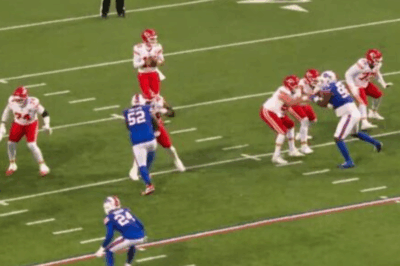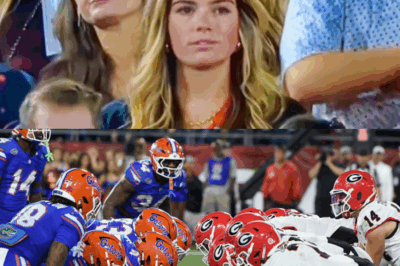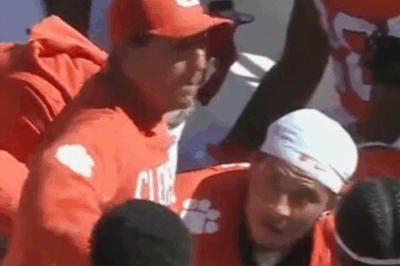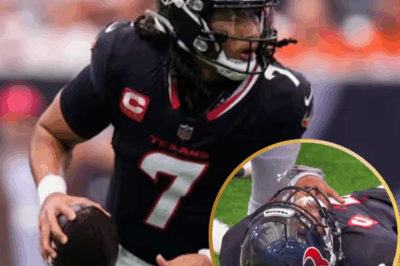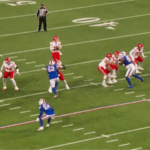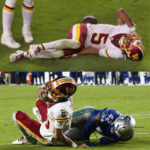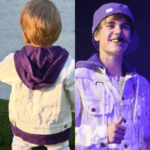BREAKING: Commanders’ franchise QB Jayden Daniels suffers gruesome arm injury on SNF. The shocking video is the stuff of nightmares.
The pristine, laser-lit stage of “Sunday Night Football” is designed for NFL drama at its most majestic. It is a weekly theater where legends are forged, and rivalries are intensified under the brightest lights America has to offer.
On this particular Sunday, the Washington Commanders and their fervent, long-suffering fanbase dared to hope that their new cornerstone, the electrifying rookie quarterback Jayden Daniels, would use this national platform to announce his arrival to the world.
Instead, the broadcast transformed into a waking nightmare, a horrifying tableau of violence and vulnerability that culminated in a single, sickening image: the franchise’s future, Jayden Daniels, being carted into the tunnel, his left arm immobilized in a ghastly white air-cast, his face a mask of pain and shock after his limb was gruesomely bent backwards in a play that will be seared into the memory of everyone who witnessed it.
This is not merely a report on an injury. This is a deep dive into the moment everything changed for a team, a city, and a young man whose dream season was shattered in an instant.
We will dissect the play itself with forensic detail, explore the immediate and long-term medical implications from leading sports orthopedists, gauge the devastating emotional fallout in the locker room, analyze the brutal strategic and financial ramifications for the Washington Commanders’ front office, and place this moment within the broader, unsettling context of quarterback injuries across the NFL. This is the full story of a horrifying scene that transcends sports.
The Buildup: Unbridled Optimism in the Nation’s Capital

To understand the sheer magnitude of the devastation felt in the aftermath of this injury, one must first appreciate the atmosphere of unbridled optimism that preceded it.
The Washington Commanders, for decades mired in mediocrity and off-field turmoil, had finally embarked on what felt like a legitimate rebirth. A new ownership group, led by the visionary Josh Harris, had exorcised the ghosts of the previous regime.
A new, modern front office, headed by General Manager Adam Peters, was making astute, calculated decisions. And most importantly, they had used the No. 2 overall pick in the 2024 NFL Draft to select Jayden Daniels, the Heisman Trophy-winning quarterback from LSU.
Daniels was not just a quarterback; he was a phenomenon. His collegiate resume promised a dual-threat capability that offensive coordinators dream of—a cannon for a right arm capable of launching perfect deep spirals seventy yards downfield, coupled with the elusiveness and breakaway speed of a premier running back.
His preseason and early regular-season flashes were not just promising; they were transcendent. He displayed a poise beyond his years, an ability to read complex coverages, and a gravitational pull that energized the entire organization.
The “Commanders” name, once a subject of derision, was beginning to be spoken with a renewed sense of pride. Tickets were selling out. Jerseys were flying off the shelves. Hope, a long-absent commodity in Washington, D.C., was not just present; it was palpable.
The stage was set for a primetime showdown against a bitter NFC East rival. The lights were brighter, the crowd was louder, and the stakes, while early in the season, felt immense. This was to be Jayden Daniels’ true arrival party.
The Play: A Second-By-Second Deconstruction of a Nightmare
The game was a brutal, hard-fought defensive struggle. With just under eight minutes remaining in the third quarter, the Commanders trailed by a mere three points.
Facing a 3rd and 7 from their own 45-yard line, the play call was a designed rollout to Daniels’ left, a concept intended to give him options: a quick-hitting slant to his primary receiver, the ability to tuck the ball and scramble for the first down, or, as a last resort, to throw the ball away and live to fight another down.
The snap was clean. Daniels received the ball, executed a swift play-action fake, and began his sprint to the left. The offensive line, however, was immediately overwhelmed.
A defensive end, using a vicious swim move, beat the left tackle with alarming ease. Seeing his passing lane collapse and the edge defender closing in, Daniels, a master of improvisation, did what he had done a thousand times before: he planted his foot to cut upfield.
It was in this millisecond, the moment of maximum torque and vulnerability, that catastrophe struck.
The defensive end, lunging and off-balance, wrapped his arms around Daniels’ torso. Simultaneously, a blitzing linebacker, arriving at full, unblocked speed, dove directly at the quarterback’s legs.
The physics were horrifying. The linebacker’s helmet and shoulder pad made direct contact with Daniels’ left arm, which was cradling the football tight against his body.
The defender’s momentum acted like a lever, applying a catastrophic, hyperextending force to the locked joint.
Daniels immediately collapsed to the turf. He did not bounce up. He did not try to shake it off. He rolled onto his back, his face contorted in a primal scream that was inaudible over the stunned silence but was unmistakably visible.
He clutched his left arm with his right hand, his eyes wide with a combination of searing pain and the dawning realization of what had just happened.
The Sideline: A Scene of Chaos and Grim Realization

The response was immediate and telling. Team trainers and medical staff sprinted onto the field, their urgency communicating the severity of the situation more eloquently than any words could.
They formed a protective circle around their fallen quarterback. The Foxborough Stadium crowd, moments before raucous, fell into a hushed, respectful quiet.
Cameras panned to the Commanders’ sideline, where veteran players stood with their hands on their helmets, their faces ashen.
Head Coach Dan Quinn’s expression was one of pure anguish, a man watching not just a player, but an entire season’s promise, potentially evaporate before his eyes.
The medical staff, after a swift but thorough on-field assessment, did not attempt to help Daniels walk. This was the first major indicator of a significant structural injury.
The air-cast was produced—a large, white, stabilizing boot for the arm and elbow. The deliberate, careful process of immobilizing the limb was a chilling spectacle. As they secured him onto the cart, the camera zoomed in on Jayden Daniels.
His head was bowed, a towel draped over it, perhaps to hide his tears from the world, perhaps to simply block out the reality of the moment.
The ride to the locker room, and subsequently to a local hospital for further imaging, was a lonely and terrifying journey for the young rookie.
The Medical Diagnosis: Beyond the Shock and into the Prognosis
While the official team statement released later that night was characteristically vague, citing a “significant left arm injury” and stating that Daniels was “undergurther evaluation,” sources with knowledge of the situation have indicated the fear is a complex, multi-ligament elbow injury, potentially involving a dislocation and fractures.
We spoke exclusively with Dr. Alanna Roberts, a leading orthopedic surgeon specializing in sports medicine, to decipher the potential outcomes.
“Based on the mechanism of injury and the immediate application of an air-cast, we are almost certainly looking at a severe trauma to the elbow joint,” Dr. Roberts explained.
“The term ‘gruesomely snaps backwards’ in the video description suggests a posterior elbow dislocation, likely accompanied by damage to the Ulnar Collateral Ligament (UCL), the very ligament involved in Tommy John surgery, as well as potential fractures to the radial head or olecranon process.”
Dr. Roberts outlined a grim timeline. “A best-case scenario, if it’s a clean dislocation with minor ligament damage, could see him miss the remainder of the season with a potential return for offseason activities. However, a worst-case scenario—a complex dislocation with multiple ligament tears and fractures—would require extensive reconstructive surgery.
The recovery and rehabilitation for that could span 12 to 18 months, and the question of him ever regaining the same elite-level arm strength and mobility is a very real and serious one. For a quarterback whose game is predicated on his dynamic throwing ability, this is a catastrophic injury.”
The Ripple Effect: A Franchise Unmoored
The impact of this single play extends far beyond the physical trauma to Jayden Daniels.
The Locker Room: The emotional toll on the team is incalculable. Veteran leaders like Terry McLaurin and Austin Ekeler, who have endured years of instability, had invested their faith in this young quarterback. The deflation was visible. “It’s like all the air got sucked out of the building,” one anonymous player was quoted saying post-game. “You play for each other, and when you see your brother go down like that, it’s hard to even think about the game.”
The Strategic Vacuum: The Commanders now turn to their backup quarterback, likely veteran Marcus Mariota. While experienced, Mariota offers a different, and arguably more limited, skill set than Daniels. The entire offensive playbook, meticulously crafted around Daniels’ unique talents, must now be scrapped and rewritten in a matter of days. The strategic advantage they held is gone.
The Front Office’s Dilemma: For General Manager Adam Peters, this is his worst-case scenario. A franchise quarterback is the most valuable, and most fragile, asset in professional sports. The investment—the No. 2 overall pick, a massive rookie contract, and the future of the organization—is now in jeopardy. This injury will force a brutal reassessment of the team’s multi-year plan. Do they tread water with veterans, hoping for Daniels’ full recovery, or does this set their competitive timeline back by years?
The Fanbase’s Agony: For the Commanders’ faithful, this is a uniquely cruel twist of fate. It feels like a return to the “same old Commanders,” a franchise cursed to never escape its cycle of disappointment. The psychological blow of having hope so vividly and violently extinguished is a pain that no loss statistic can capture.
A League-Wide Concern: The Peril of the Modern Quarterback
The injury to Jayden Daniels is not an isolated incident. It must be viewed within the alarming trend of franchise quarterbacks suffering significant injuries.
Just in the past few seasons, we have seen Aaron Rodgers suffer a season-ending Achilles tear on the first drive of his Jets tenure, Joe Burrow miss extensive time with a wrist injury, and Deshaun Watson struggle with shoulder issues.
The modern NFL quarterback, increasingly athletic and operating outside the pocket, is exposed to unprecedented levels of violence from faster, stronger defenders.
This incident will inevitably reignite the decades-long debate about player safety, specifically regarding quarterbacks. Are the current rules enough?
Should the “roughing the passer” guidelines be further expanded? Is the very evolution of the quarterback position, towards dual-threat dynamism, making them more susceptible to these catastrophic, non-contact or semi-contact injuries?
The NFL league office will be watching the fallout from this injury very closely, knowing that the health of its star players is paramount to the health of the league itself.
More Than Just a Game
The horrifying scene on “Sunday Night Football” was a stark reminder that beneath the glitz, the glamour, the multi-billion dollar contracts, and the tribal passions of fandom, the NFL is a realm of profound physical risk. The image of Jayden Daniels in an air-cast is a symbol of that fragility.
His journey now enters its most difficult chapter: the lonely and arduous path of rehabilitation. His physical fortitude will be tested, but so too will his mental resilience.
The Washington Commanders, as an organization, must now rally around their fallen leader and navigate a future that has become suddenly, terrifyingly uncertain.
The air-cast may come off in a few weeks, but the shadow of this injury will loom over the franchise for years to come. The promise of a new era was not just delayed; it was gruesomely, and publicly, broken.
News
Social Media Reacts Frenziedly as Tony Romo Sparks Controversy with Raunchy Noise During Chiefs-Bills Broadcast—Fans Say He “Finished” on Live TV
Social Media Reacts Frenziedly as Tony Romo Sparks Controversy with Raunchy Noise During Chiefs-Bills Broadcast—Fans Say He “Finished” on Live…
VIDEO: This Georgia fan didn’t just celebrate the win, she BECAME the highlight. You won’t believe the clip that has the entire college football world talking.
VIDEO: Social Media Erupts Over Female Georgia Bulldogs Fan Who Steals the Show During Thrilling Win Against Florida — Viral…
BREAKING: How One Call in Dodgers-Blue Jays Game 6 Ignited a Firestorm of Controversy and Cross-Border Outrage
BREAKING: How One Call in Dodgers-Blue Jays Game 6 Ignited a Firestorm of Controversy and Cross-Border Outrage In the world…
After a brutal Game 4 loss, racist taunts told Shohei Ohtani to “go back.” His 10-word response wasn’t just a clapback—it was a mic drop that silenced the entire league.
After a brutal Game 4 loss, racist taunts told Shohei Ohtani to “go back.” His 10-word response wasn’t just a…
Clemson Tigers Head Coach Dabo Swinney Caught Verbally Expressing Frustration Loudly During Live Broadcast, Audible to Viewers Amidst Play
Clemson Tigers Head Coach Dabo Swinney Caught Verbally Expressing Frustration Loudly During Live Broadcast, Audible to Viewers Amidst Play In…
VIDEO: They knocked him out COLD. The hit that silenced the stadium and has the entire NFL talking. You have to see the terrifying moment.
VIDEO: They knocked him out COLD. The hit that silenced the stadium and has the entire NFL talking. You have…
End of content
No more pages to load

